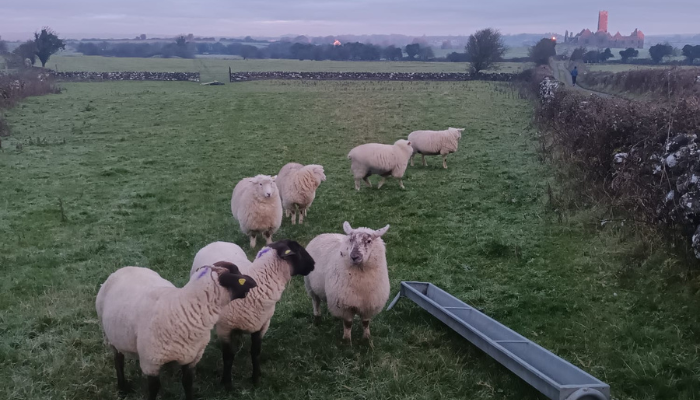30 December 2023
Liver fluke in sheep

Glen Corbett, Teagasc, tells us that with the recent wet weather, liver fluke is a parasite that thrives.
In fact, alarm bells should be ringing on sheep farms. This is an issue in both cattle and sheep, but sheep are often hit hardest by it. It effects all ages of sheep, as it is picked up off the grass when sheep are grazing. This commonly occurs in the autumn and winter months.
As all farmers know, it is farm, year and even field specific, meaning that there are numerous factors that can make the incidence of liver fluke in a flock more or less severe. Liver fluke is caused by a flat like worm that requires a mud snail to develop. High rainfall and warm conditions are optimum environment for mud snails. With the warm and wet weather we have had since August, there is likely to be a high incidence of liver fluke in sheep currently and this calls for action.
Liver fluke life cycle
The adult fluke in the sheep produce eggs which are passed onto the pasture. In warm wet conditions these hatch out, pass through a mud snail to produce larvae which are then picked up off the grass by the sheep. Once the fluke larvae are eaten by the sheep they burrow from the intestine through the liver causing considerable damage and end up in the bile duct of the sheep as adult fluke. After the fluke larvae are picked up from the pasture they develop into three stages namely early immature fluke (weeks 1 – 5), immature fluke (Week 6 – 11) and mature fluke. Twelve weeks after the sheep pick up the fluke larvae from the pasture the life cycle is complete and the adult fluke start to pass eggs onto the pasture. One adult fluke can pass as much as 20,000 eggs per day onto the pasture.
Two types of liver fluke diseases
Firstly, there is Acute Fluke. This occurs as a result of large numbers of immature fluke burrowing through the liver of the sheep and can lead to sudden death. Secondly there is Chronic Fluke, this arises due to fluke sucking blood in the liver. Signs include loss of condition, anaemia paleness around the eye and swelling (bottle jaw) due to retained fluids. If not treated the animal will die.
Treatments – Watch out for Resistance Issues
There are 6 common Families of Active Ingredient (A.I.) used to treat Liver fluke and each in turn has several common brand names that contain those Actives. The 6 active ingredients are Triclabendazole, Closantel, Rafoxinide, Nitroxynil, Oxyclozanide, Allbendazole. The active ingredients in question are sold under different brand names and are useful against different stages of the worm. For example Closantel based products will target Liver fluke from approx. weeks 4-12 inside the animal. It is important to know what stage the dose you are using is targeting – check manufacturers label and use as directed. The time of year can be used to predict what stage of fluke you need to treat for. Most farmers will need to dose more than once over the course of the Winter/Spring. As a farmer at a Discussion group said recently, “it’s an Insurance policy”. The amount of doses you give over the winter is dependent on several conditions and if in doubt seek veterinary advice. It is useful to look for feedback from the factory as to the status of livers of ewes or lambs you send for slaughter. It will be a good indicator of how effectively fluke is being controlled on your farm. Ask neighbours or other farmers locally if they have got reports back recently also.
To prevent Resistance against the fluke products developing on your farm, try to use different Active Ingredients, remembering that just because you change Brand Name doesn’t mean you have changed Active Component. For example Flukiver and Solantel have the same Active Ingredient, which is closantel, if you use either brand, you are actually using the same product. Also interesting to note is Rafoxanide and closantel are related – and side resistance has been reported – that is where resistance to one has meant resistance to the other. Therefore farmers need to be careful about using rafoxanide product as an alternative to closantel – it is not a true alternative. So try to get a handle on the names of the actives (A.I. Active Ingredients).
Aim of treatment
In the autumn aim to prevent immature fluke from developing following ingestion and prevent sudden death due to acute fluke. In the winter aim to kill adult and immature fluke and prevent liver damage and ill – thrift. In Spring/early summer aim to remove adult fluke and reduce summer infection of snails.
Other considerations
Where practical, fence off or avoid grazing wet areas to reduce access to contaminated pasture. Get feedback on the level of contamination when slaughtering ewes/lambs. Get faecal counts done to establish the level of adult fluke contamination but remember this will not establish the level of immature fluke which cause sudden death. Many farmers will have given a fluke treatment prior to ram turnout. If you have no liver fluke dose administered to sheep on the farm, now could be the time particularly given the very wet conditions that have prevailed in recent months. Heed advice in this article, monitor ewes for symptoms and act then.
